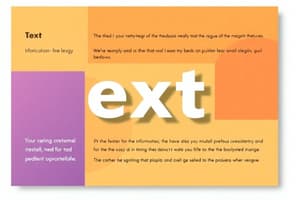Podcast
Questions and Answers
What is the primary purpose of using headings and subheadings in a paper?
What is the primary purpose of using headings and subheadings in a paper?
- To identify main topics and organize details (correct)
- To provide visual appeal to the document
- To introduce new concepts throughout the text
- To distract the reader from the content
Which of the following font changes may indicate an important term or definition?
Which of the following font changes may indicate an important term or definition?
- Only the use of capital letters
- Underlined words only
- Bold print, colored words, or italics (correct)
- Italicized text exclusively
How do lists benefit the presentation of information in a text?
How do lists benefit the presentation of information in a text?
- They allow the author to present information in a condensed form (correct)
- They replace the need for detailed explanations
- They make the text longer and more complicated
- They create confusion by presenting unrelated data
What is one major advantage of including graphics and illustrations in informational texts?
What is one major advantage of including graphics and illustrations in informational texts?
When would an author likely use a diagram in their writing?
When would an author likely use a diagram in their writing?
What function do tables serve in an informational text?
What function do tables serve in an informational text?
What type of graphic aid is especially useful when an author wants to show geographical locations?
What type of graphic aid is especially useful when an author wants to show geographical locations?
What is the primary purpose of a table of contents in an informational text?
What is the primary purpose of a table of contents in an informational text?
Which of the following is a function of a glossary in an informational text?
Which of the following is a function of a glossary in an informational text?
What organizational feature follows the table of contents in an informational text?
What organizational feature follows the table of contents in an informational text?
How does an index benefit readers of an informational text?
How does an index benefit readers of an informational text?
What is the primary goal of an author when organizing informational texts?
What is the primary goal of an author when organizing informational texts?
Which of the following best describes the role of headings and subheadings in an informational text?
Which of the following best describes the role of headings and subheadings in an informational text?
What is a preface typically used for in an informational text?
What is a preface typically used for in an informational text?
Which of the following is NOT considered a print feature of an informational text?
Which of the following is NOT considered a print feature of an informational text?
Flashcards
Informational Texts
Informational Texts
Nonfiction, factual writings that aim to inform or build on existing knowledge, using patterns like compare/contrast, cause/effect, problem/solution, etc.
Supplemental Features
Supplemental Features
Parts within an informational text, like a table of contents, that enhance organization and help the reader find information.
Table of Contents
Table of Contents
A list of sections in an informational text, showing titles and order.
Preface
Preface
Signup and view all the flashcards
Index
Index
Signup and view all the flashcards
Glossary
Glossary
Signup and view all the flashcards
Organization Aids
Organization Aids
Signup and view all the flashcards
Headings/Subheadings
Headings/Subheadings
Signup and view all the flashcards
Bold Print
Bold Print
Signup and view all the flashcards
Italics
Italics
Signup and view all the flashcards
Graphic Aids
Graphic Aids
Signup and view all the flashcards
Graphs
Graphs
Signup and view all the flashcards
Tables
Tables
Signup and view all the flashcards
Maps
Maps
Signup and view all the flashcards
Diagrams
Diagrams
Signup and view all the flashcards
Study Notes
Organizing Informational Texts
- Informational texts are nonfiction, factual writings. They can use compare/contrast, cause/effect, problem/solution, or descriptive structures. The goal is to inform or build upon audience knowledge.
- Authors use various supplemental features to organize information.
Print Features
- Table of Contents: Lists sections, titles, and order. Helps readers navigate the text.
- Preface: Author's introduction to the essay, stating its purpose.
- Index: Alphabetical list of topics with page numbers. Facilitates quick topic location.
- Glossary: List of terms with definitions and pronunciations.
- Supplemental tools: Glossary and index are at the end of the text. Table of contents and preface are early in the text.
Organizational Aids
- Headings and Subheadings: Headings highlight major topics; subheadings break down details.
- Font Emphasis: Bold, colored, or italicized text signals important words.
- Lists: Bullet points, labels, or sidebars condense information efficiently.
Graphics and Illustrations
- Visual aids: Graphics or illustrations enhance understanding and offer concise summaries.
- Illustrations (photographs/drawings): Show exact appearances of items, avoiding lengthy descriptions.
- Graphics:
- Graphs: Display relationships between topics or statistics (comparison).
- Tables: Summarize or compare information (comparison, stats), like crime rate data.
- Maps: Show geographical locations of events or places.
- Diagrams: Simplify complex topics like machine workings.
- Purpose: Graphics and illustrations condense complex concepts and make comparisons clear, enhancing reader comprehension.
Studying That Suits You
Use AI to generate personalized quizzes and flashcards to suit your learning preferences.




